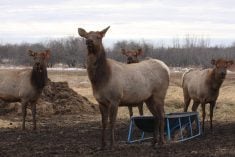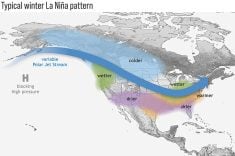Millet and corn are two of the most popular options for cattle producers looking to use field or swath grazing to reduce their winter feeding costs.
A Manitoba farm production adviser says it’s a tossup as to which crop is better.
“Everybody is looking at corn, but some of the guys who are into corn are looking at millet,” said Dean Stoyanowski of Arborg, Man.
“It depends on your land base. Is your land going to produce good corn, or would you be just as well off going with millet for less money?”
Read Also

Canadian Food Inspection Agency extends chronic wasting disease control program consultation deadline
Date extended for consultation period of changes to CWD program
Stoyanowski said that while corn costs $35 to $50 per acre for seed, millet can be planted for $12 to $18. From his experience, he found that corn input costs for winter grazing, including seed, fertilizer and herbicide, came out at $120 per acre, while millet came to $65.
The millet yielded 11 tonnes while the corn ended up at 15 tonnes.
“Pricewise, it’s around half the cost when you’re growing millet, but of course carrying capacity is a lot less than with corn,” he said. “Seed cost for millet is minucule compared to corn.”
The decision would be easier if farmers had a crystal ball offering long-term weather forecasts.
“Corn needs a lot of moisture,” Stoyanowski said. “Millet really likes it dry. It has a fibrous root system and it seems to go and look for moisture.”
Cattle tend to waste less when swath grazing millet, and the waxy leaves and stems shed water and stay in better condition longer in the swath than oats or barley, he added.
Raynold Gauthier, who operates Manitoba Millet King Seed Inc., has been selling a Proso Cerise millet variety that he grows on his 800 acre operation near St. Claude, Man. Business has been picking up in recent years, and he has added three contract growers in Saskatchewan.
Gauthier said his millet, which he sells for 40 cents a pound, can be swathed after 60 days and is able to produce a good crop on just a few inches of rain. Seed costs $12 per acre if 30 lb. are seeded per acre. Gauthier uses about 60 lb. of nitrogen per acre for growing seed, but he added that good results have been seen in Alberta with 160 lb. of 46-0-0.
If the summer is hot, it can reach five to six feet in height with high protein content. Weed control is best done with Buctril M at a three-quarter rate, he added.
“The cows prefer it to oats or barley. Guys up in Saskatchewan and Alberta are calling it ice cream because they don’t leave anything behind,” he said. “It’s like summer fallow because they even eat the stubble.”
Besides cheaper seed costs and other inputs, millet is also at an advantage because wildlife aren’t attracted to it and grasshoppers aren’t as eager to eat it due to the mature plant’s hairy stems.
Ron Catt of Poplar Creek Farm, which is halfway between Holland and Austin in southern Manitoba, sells an open pollinated grazing corn that he developed as a way to avoid the high cost of buying hybrids.
He has three varieties rated for 2,250 to 2,350 heat units that he sells for $100 per 55 lb. bag. At 20,000 to 24,000 plants per acre, seeding costs are about $25.
He recommended Accent or Battalion for weed control. Less nitrogen is needed to fertilize the corn, he said, adding that with on-field winter grazing, the cow manure helps offset the cost of this input after a few years.
“We figure that we can put in an acre of corn for about $75.”
With open pollinated corn, the field population is more diverse than with hybrids bred for specific traits and consistency.
“You get more natural pest resistance, and you get better overall drought hardiness because some plants might be hardier than others,” said Catt, who added that greater diversity means nutritional value is higher as well, with protein of up to 12 percent.
“The field itself might look a bit more variable, but for grazing that’s not a problem. And because it’s a diverse population, we find that it does OK on 50 lb. of nitrogen per acre, or a well-manured field or both.”
Catt said past silage yields averaged about 10 tonnes per acre. For grazing, that is roughly the same as 200 cow days per acre.
He started building up the seed stock on small plots in 2000. Now in fall, he walks through the field and picks 200 cobs from the best plants to keep for seed. He plants these the following spring next to the new crop.
“It crosses into it, and so you breed up the ladder.”
In this way, he has been able to naturally select a seed stock that is well adapted to local conditions.
Catt began selling his corn variety last year. Buyers have come from 80 kilometres north of Dauphin, Man., to Prince Albert, Sask., and the Peace River country of Alberta, he said.
One way to hedge against Mother Nature would be to plant millet and corn and swath graze the millet in November and early December. When the snow gets deep, the standing corn would be easier than the millet for the cows to reach, he said.














